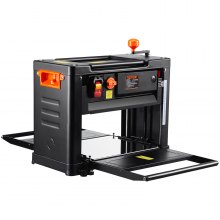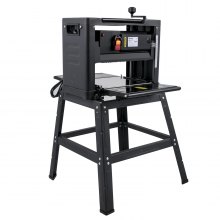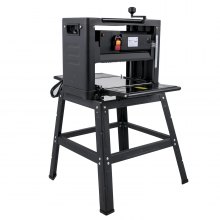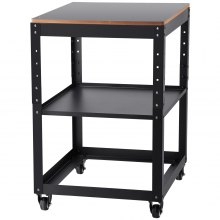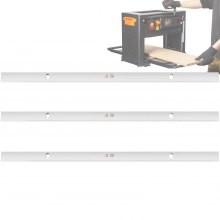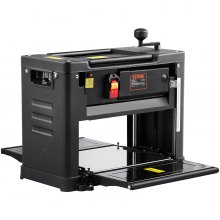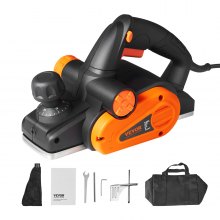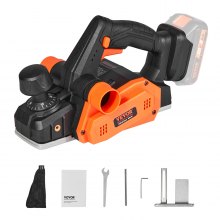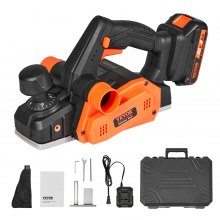Precision in Woodworking With VEVOR: The Art and Science of Thickness Planers
Carpentry, the ancient art of ancient civilizations, has evolved from rudimentary tools to modern precision and efficient machinery. In these developments, complex designers lie ara is an indispensable asset, enabling woodworkers to achieve unparalleled accuracy and precision in the woodworking process.
Where craftsmen once relied solely on hand planes and molds to achieve and simplify the desired results, modern technology has introduced various automated solutions designed to simplify the process. Among these, VEVOR stands out as a beacon of innovation, offering various thickness planers renowned for their precision, reliability, and ergonomic design.
What is a Thickness Planer, And How Does It Work?
A thickness planner, also known as a thickener, is a woodworking machine designed to accurately and consistently reduce the thickness of thick wood or planks. They are major tools in the woodworking arsenal, especially for wood shaping.
How a thickness planer works is simple:
Preparation
Before using the thickness planer, make sure the wood is flat, straight, and free of defects or debris that could damage the machine or affect the quality of the cut.
Setting the Depth
Confirm the initial weight of the wood and the amount to be removed, and adjust the cutting head or bed height to accommodate the desired thickness.
Feeding the Wood
Turn the thickness planer and insert the wood into the machine, ensuring it contacts the two feed rollers. Use a push or push stick to guide the wood through the planer, keeping it consistent and even for the feed.
Repeating Passes
Depending on the final and initial tree weights, several passes may be required to achieve the desired results. After each period, adjust the cutting head or bed height as necessary and repeat until you reach the desired result.
Final Inspection
Check for smoothness and uniformity once the frames are adjusted to the desired size. Make final adjustments as needed to ensure the quality of the finished product.
Different Applications Of Thickness Planers
Thickness planers are versatile woodworking machines with many applications due to their ability to reduce the thickness of the wood accurately and efficiently. Here are some applications for thickness planers.
Dimensioning Lumber
One of the main uses of a thickness planer is for measuring the thickness of wood. When working with plain or wood saws, size adjusters can quickly and accurately reduce the size to the desired level, allowing the wood to be handled more efficiently and ready as it will be processed again.
Smoothing Surfaces
Manufacturers of rigid aircraft excel at smoothing irregular or fragile wood. The wood passes through the planer to remove imperfections such as mill marks, saw marks, and small surface irregularities, resulting in a smooth and even surface suitable for finishing or joining.
Creating Uniform Thickness
Sizing designers ensure that all surfaces are uniform. This uniformity is essential for industries that require consistently complex products, such as frames, tablecloths, cabinet doors, and furniture. By adjusting the planer’s settings, woodworkers can achieve more accurate and uniform sizes, improving the quality and appearance of their work.
Precision Planning: Mastering Techniques for Consistent Thickness on Your Wood
Achieving a consistent tree thickness is a hallmark of precision woodworking, requiring a thorough knowledge of techniques and attention to detail. Whether you’re doing complex furniture, cabinetry, or woodworking, successful planning is essential to achieving high-performance results.
Feed Rate Control
Maintain a constant feed rate as you move logs through the thickness planer. Too fast a feeding speed can result in uneven cuts or snipes, while too slow a feeding speed can cause burns or chatter marks on the surface of the wood. Try different feed rates to find the best speed for smooth and consistent results.
Use of Infeed and Outfeed Support
Provide adequate tree support before and after planning to reduce snipe and ensure regular feeding. Infeed and outfeed tables, roller stands, or auxiliary supports can help support longer or heavier workloads, maintaining stability and reducing the risk of distraction during installation.
Check for Uniformity
Check the plank thickness periodically with a digital thickness gauge or calipers to ensure uniformity across the surface. Check for any thicker or thinner areas than desired and adjust the planer setting accordingly.
Minimize Tear-out
Pay attention to the direction of the wood grain when feeding through the thickness planer to minimize wear and tear on the surface. The grain's orientation can affect the cut's quality, so planning somewhere parallel to the grain or at an angle can cause tearing or cracking. Feed the trees with grain whenever possible for an easy, clean cut.
Why Choose VEVOR Thickness Planers?
VEVOR offers a myriad of benefits, including cutting-edge technology, compatibility, rapid charging, durability, safety, eco-friendliness, and excellent customer support. With VEVOR chargers, golfers and course operators can trust in a reliable and efficient charging solution that enhances the overall golfing experience while meeting the demands of modern golf cart technology.
VEVOR's thickness planers are competitively priced, providing excellent value for money. They are also easy to maintain with accessible components and simple maintenance procedures.VEVOR prioritizes safety in the design of its thickness planers, incorporating features that can make operators work confidently. They are also versatile, catering to several woodworking needs.
FAQs About Thickness Planers
How do I prevent snipes when using a thickness planer?
The snipe means a slight dip or bend at the end of the plank. It can be reduced by providing adequate support to the logs before and after planing. You should also adjust the infeed-outfeed table on the surface, using a slow feed and ensuring the planer blades are level and sharp.
Can I use a thickness planer to flatten warped or twisted boards?
Although thickness planers are designed to reduce the boards' weight, they are unsuitable for installing highly twisted or flat-twisted boards. Consider using a joint or hand plane to align one face of the board with one flat piece before planning how you want to do such work.
Can I place wood that is shorter than the length of the planer's bed?
While using a thickness planer to create small, accurate logs is possible, additional support or techniques may be required to ensure consistent results and prevent snipes. Accessories, sleds, or sacrifice boards will be used to support appropriate smaller projects when planning.




























